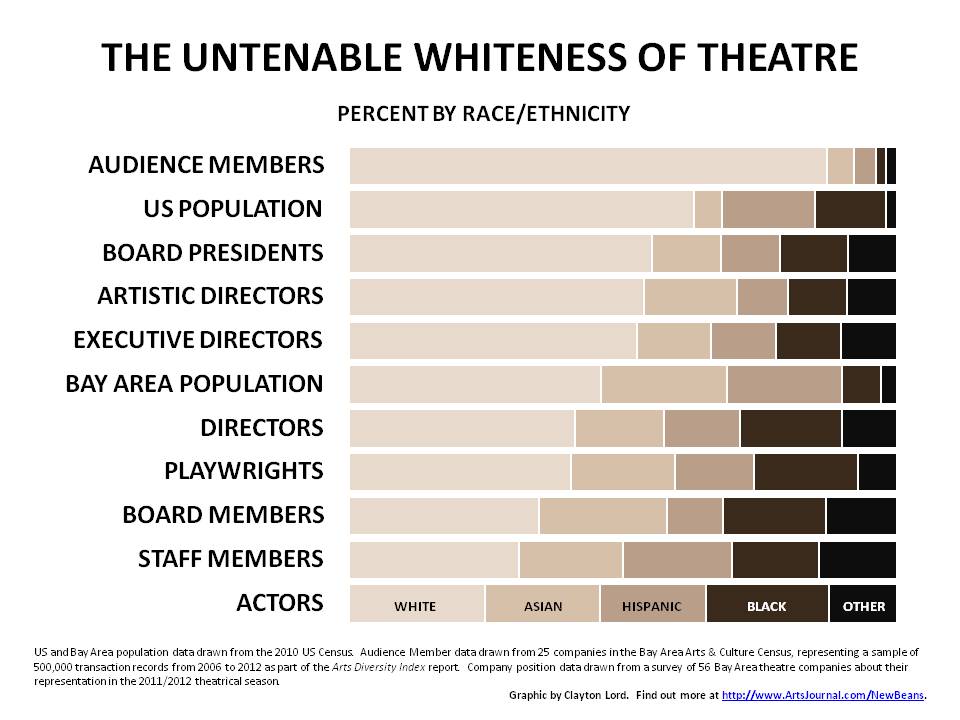Today I’m foregoing my usual verbosity in favor of a picture. This is a combination of US Census data, data from the Arts Diversity Index report and data from another survey of 56 Bay Area theatre companies about the diversity of their boards, staffs and artists. Please share and discuss–the Arts Diversity Index report should be coming out shortly (we shared an executive summary and short presentation of some of the data at the Theatre Bay Area conference earlier this week). Click to enlarge the image.
Comments
Trackbacks
-
[…] white and male, and this year Arts Diversity Index for 56 Bay Area theater companies, by Clayton Lord, which outlines the “Untenable Whiteness of […]


I might retitle this “the untenable whiteness of theater audiences.” It looks like below the exec line, theaters are MORE diverse than the Bay Area population – directors, playwrights, board members, staff, actors. Even the executives aren’t horribly off-track. But the audiences!
That’s super-interesting, because it suggests that you have this fairly diverse machine manufacturing a product for a fairly monolithic audience. Either theaters are really good at “targeting” content to whites, or there’s something else going on in terms of what prospective audiences are bringing to their perception of who theater is for.
I bet that the wealth distribution by ethnicity would look similar to the theater audience. Hard to go to the theater when you’re working 3 minimum wage jobs.
Is it just a perception of who theater is for that is keeping the audience so white, or is the theater just intimidating to those who are not used to attending.
By the way, the title of this article is brilliant, Clay. Caught my eye IMMEDIATELY.
The line at the bottom, for actors, looks incredible to me. Is that really what the distribution of actors in the Bay Area is? The “other” category is slightly smaller, but aside from that it looks like practically equal numbers of White, Asian, Hispanic, and Black actors. It’s been decades since I’ve attended a play in the Bay Area, but Los Angeles, which is as diverse as the Bay Area, has a theater scene where the actors are still overwhelmingly white. At least in the plays that I attended. Obviously there were exceptions such as the East West Players.
I suspect LA is filled with actors who came there to be in movies. Might explain a lack of diversity on stage.
Thank you for posting this! Over here on the East Coast, the group I’m part of, AAPAC (Asian American Performers Action Coalition), has taken statistics on the New York theater scene as well, although we didn’t take all the same “measurements” when factoring our numbers. If you’d like to compare, our website is http://www.aapacnyc.org, and on the homepage click on “Stats Report”.
After holding several discussions with theater artists of all levels, in forums both large and small, about exactly this issue (but especially as it pertains to Asian American actors), the reasons given to us about why these numbers are the way they are are manifold. The collision of entrenched history with a rapidly diversifying population has resulted in a bizarre blindness – and resistance – to change. White writers, for the most part, continue to write about what they immediately know, which is their own history. Then it’s mostly white writers who are championed by the major theater production companies, mostly white directors hired to direct the plays, and mostly white actors hired to tell the stories. After a while, audience members of color start to ask, “Where am I on that stage, other than as a token, or in a play about my people that happened 2 years ago?” But In Broadway houses, there are numbers proving that when a play about a specific ethnic group is produced, audience members of that ethnicity suddenly appear in DROVES. Producers are missing out on goldmines and don’t even know it…
Obviously there’s much more to discuss than I can encapsulate here, si for time’s sake I’ll leave it with this: the US population numbers are going to flip very, very soon. By 2043, the U.S. will no longer be majority white. If theaters want to grow and diversify their audiences, it’ll behoove them to find ways to reach out to diverse audiences – and telling, then advertising, stories that include people of more races and ethnicities will be a great way to start.
looks like we need more white actors
Theater audiences are also getting older. When I look out over the audiences at my husband’s one-man shows, I see white hair. I’d say the average age of his audience members is about 70. Will there be future generations of theater goers who seek out new and challenging shows? Today I think people tend to flock to spectacles with Las Vegas-y effects.
A chart of age ranges would show a very similar pattern, with actors and staff skewed young, and audiences skewed geriatric. Again, economics is the most obvious way to account for this.
Do the numbers reflect the number of actors and directors, etc., that live in the Bay Area or the number that worked for the various theater companies during this period? I understand that the audience members would be actual attendees for this particular year.